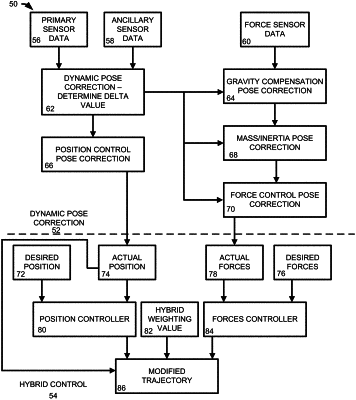| CPC B25J 9/1633 (2013.01) [B25J 9/1638 (2013.01); B25J 9/1653 (2013.01); B25J 9/1664 (2013.01); B25J 13/085 (2013.01); B25J 13/088 (2013.01); B25J 13/089 (2013.01)] | 20 Claims |

|
1. A system comprising:
at least one object configured to be moved by a robotic system;
at least one force sensor positioned on the at least one object to measure actual forces associated with the at least one object at a time in a first coordinate system;
at least one position sensor positioned on the at least one object to measure an actual position associated with the at least one object at the time in a second coordinate system, wherein the second coordinate system is different from the first coordinate system; and
a controller comprising:
a non-transitory memory storing executable instructions; and
a processor for executing the instructions to:
receive, from the at least one force sensor, the measurement of the actual forces associated with the at least one object at the time in the first coordinate system;
receive, from the at least one position sensor, the measurement of the actual position associated with the at least one object at the time in the second coordinate system;
retrieve desired forces to be associated with the at least one object at the time in the first coordinate system;
retrieve a desired position to be associated with the at least one object at the time in the second coordinate system;
retrieve a trajectory of the at least one object based on the desired forces and the desired position;
establish a common reference frame, different from at least one of the first coordinate system or the second coordinate system, for the actual forces, the actual position, the desired forces, and the desired position;
transform the actual forces, the actual position, the desired forces, and the desired position to the common reference frame;
determine an explicit force control output based on the difference between the actual force and the desired force at the time in the common reference frame;
determine a position control output based on the difference between the actual position and the desired position at the time in the common reference frame;
determine a hybrid weighting value in the common reference frame based on an amount of position control required for the at least one object to reach the desired position at the desired forces at a future time and an amount of explicit force control required for the at least one object to reach the desired position at the desired forces at the future time, wherein the hybrid weighting value is variable in time based on at least one control variable;
determine a change in position associated with the at least one object at the time and a change in forces associated with the at least one object at the time based on the hybrid weighting value, the explicit force control output, and the position control output;
modify the trajectory of the at least one object at the time based on the actual position and the change in position and the change in forces associated with the at least one object; and
move the at least one object based on the modified trajectory after the time.
|